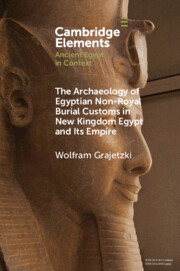Element contents
The Archaeology of Egyptian Non-Royal Burial Customs in New Kingdom Egypt and Its Empire
Published online by Cambridge University Press: 27 December 2021
Summary
- Type
- Element
- Information
- Online ISBN: 9781009064521Publisher: Cambridge University PressPrint publication: 03 February 2022
References
- 8
- Cited by

